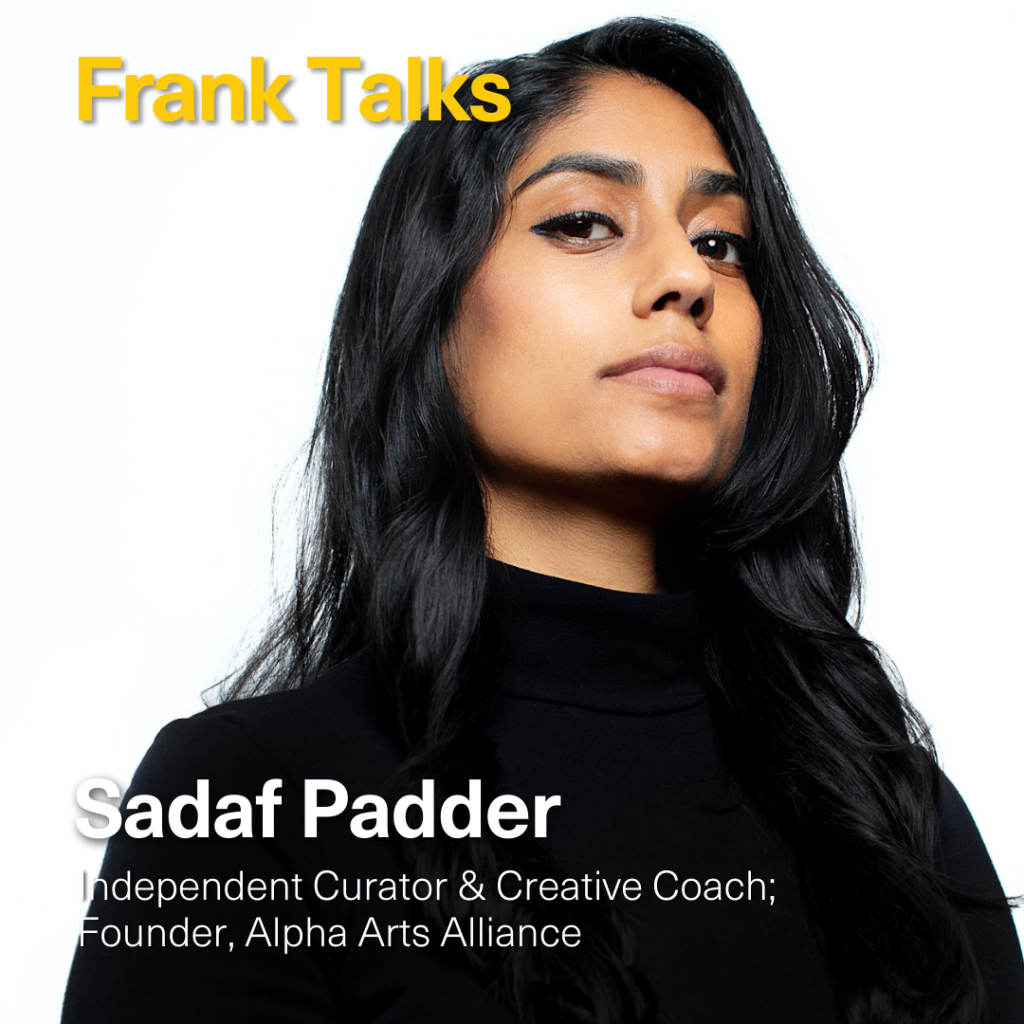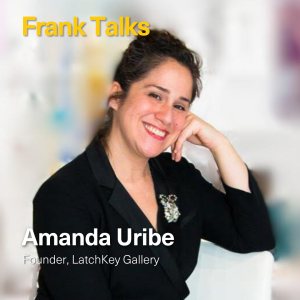Sadaf Padder is a Brooklyn-based independent curator and creative coach. After 8 years in the public school system as a teacher and administrator, Sadaf left her job to found Alpha Arts Alliance (A3), a hyperlocal arts collective.
Sadaf has curated exhibitions across the country including New York City, Los Angeles, San Francisco, Martha’s Vineyard and Philadelphia. She amplifies artists of the global majority through connective themes such as neo-mythology, ecology and social justice. Her writing and curation has been featured in LA Weekly, ARTSY, the Washington Post, ArtNews and Hyperallergic.
Sadaf also serves as board-member for the Chickweed Alliance and is a team member of Grown in Haiti, a reforestation organization in Cap Rouge, Haiti. She is a Create Change alumna with the Laundromat Project and a 2022-2023 Emily Hall Tremaine Fellow with Hyperallergic where she presented initial research on South Asian futurisms.
AF: Hi Sadaf! It is wonderful to be chatting with you today, we are excited to get to know you better. To start us off, where did you grow up and what is the arts community like there?
SP: I moved a lot as a child – from England to New York to New Jersey, where I attended secondary school. I distinctly remember the school selecting students to be a part of the visual arts program. I was not selected (I don’t even think I got a chance). This signaled to me early on that I was a non-artist. However, I always loved art and later found my way back to creating myself.
In high school, I found a sense of belonging with the few Brown and Black creatives. I started going to museums, jam sessions, artist talks. We grew up right outside of Philadelphia which has a really rich and overlooked arts ecosystem. However, many of us could no wait to leave our hometown! I moved to Washington DC upon graduating high school.
AF: Did you always know you wanted to work in the arts?
SP: Not at all. I had no idea curating was even a career path. I remember early on wanting to pursue photography then psychology. My family geared me to consider law or medicine. I studied anthropology in university and even took the LSATs. I was trying to convince myself. Upon graduating, I began teaching and spent 8 years in the public school system – first in Baltimore then in Brooklyn, where I was a Dean of Students. I began incorporating arts programming into my classroom as soon as I saw how much our schools were lacking.
AF: What was your first ever job? What is an important lesson from it that has carried with you?
SP: I was a waitress at a local NJ diner called Perkins! It made me appreciate the hard work and sheer memory folks in hospitality had to have. It also taught me grace – how to maintain decorum and kindness even when faced with difficult patrons.
AF: You are an independent curator, community organizer, and creative advisor! How do you juggle all these different roles?
SP: I’ve always been someone who was able to handle multiple things at once. My speed (I type 120 WPM), extraverted nature, and memory help. I do really credit my time as an educator and my mentor, Justin Pigeon, who was my principal. He taught me to produce events and build and maintain systems that allowed me to keep track of 400 students, 40 staff and a school-wide assembly that I ran every Friday.
Boundaries are extremely important, of course. I am a giver by nature and I love people. I have had to get really clear on who are my peers, my friends, my collaborators and when to charge for services versus when to lend them. It’s all a give and take. As visibility grows and demand increases, boundaries need to be constantly recalibrated.
AF: You are also the founder of ALPHA Arts Alliance, New York’s only active South-Asian female led arts dealership. Tell us more about why you founded ALPHA Arts Alliance, as well as your hopes and goals for its future!
SP: I was tired of looking for a space that represented me and realized if I wanted to find it, I would need to create it myself. ALPHA is amorphous – we started off providing writing and professional development services for artists.
My hope for the future is to release online artist development services in the form of interactive courses as well as a digital exhibition space.
AF: What does an average workday look like for you?
SP: Each day is different and season is different. I work well in spurts. Spring and fall are hyper-productive while winter is time for rest, reflection and strategy. I often joke that Thursday nights are like Monday mornings in the art world. I take quiet mornings and begin meetings around 10 AM. Mondays I try my best to stay home and prepare for the week. The rest of the week may look like studio visits, openings, events, site visits or research.
AF: Who are some emerging artists that you are excited about right now? Who should people keep an eye on?
SP: Rajni Perera. She is based in Toronto and makes these phantasmagorical works that deal with climate change, the migratory body, and ancestral memory.
AF: What is your process like curating an exhibition?
SP: For group exhibitions, I often start with a theme and an “anchor artist” – someone I am building a story around. I like to establish rapport with the artists and do my best to spend time and understand
Curating requires trust.
AF: Do you have any personal goals for this year?
SP: I would like to develop my critical voice by writing and publishing more often.
AF: Among the many voices you help amplify through your practice, you partner with Grown in Haiti, an organization dedicated to eco-health and regenerating Haiti. How did this partnership begin? Tell us about your fundraising exhibition ‘Let’s Grow!’.
SP: It began with love. Sidney, the co-founder of GIH, and I met in New York five years ago. He became a great friend and is now my family.
To live in Brooklyn is to recognize and honor the deep connection this borough has to the Caribbean, especially Haiti. The first communities to really welcome me in Brooklyn were Haitian-American creatives. Haiti also reminds me a lot of Kashmir, where my father is from.
Let’s Grow! is ALPHA’s third fundraising exhibition for Grown in Haiti. We are fundraising for a community center space at Grown in Haiti which will house a future artist residency program. The goal is to provide a sanctuary space for the many artists in my orbit who are thinking about land sovereignty and agriculture as well as to dismantle the deep-seated fear many people have about visiting Haiti. I’m actually here right now (at the time of this interview), my fourth visit.
AF: As you know, Art Frankly is a community that cares about job transparency and supporting fellow art professionals. What is the best piece of advice you can give about working in the art world?
SP: Use contracts and document your agreements, even with friends….especially with friends.
AF: How do you think the art world can become more transparent?
SP: Pricing! Entry point pricing for emerging art has skyrocketed. I’ve noticed the artists themselves are often unaware of how their peers are pricing and blindly trust their dealers to set their pricing for them. I would also love to see standardized consignment agreements that mandate protections for artists such as knowing who is buying your work and outlining if the consigner plans to buy themselves.
AF: Well thank you, Sadaf, for participating in Frank Talks, it has been a delight to chat with you! To finish us off, we want to ask you our classic final question: If you could own work by 5 different artists/craftspeople, who would be in your collection?
SP: Frida Kahlo, Firelei Baez, Hayv Kahraman, Hilda Palafox and Rajni Perera.




